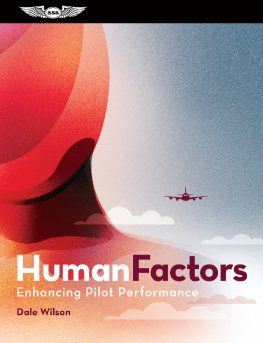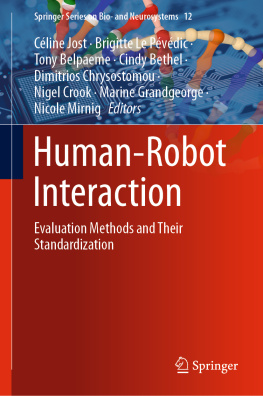EVALUATION OF RAIL TECHNOLOGY
Human Factors in Road and Rail Transport
Series Editors
Dr Lisa Dorn
Director of the Driving Research Group, Department of Human Factors, Cranfield University
Dr Gerald Matthews
Professor of Psychology at the University of Cincinnati
Dr Ian Glendon
Associate Professor of Psychology at Griffith University, Queensland, and President of the Division of Traffic and Transportation Psychology of the International Association of Applied Psychology
Todays society confronts major land transport problems. Human and financial costs of road vehicle crashes and rail incidents are increasing, with road vehicle crashes predicted to become the third largest cause of death and injury globally by 2020. Several social trends pose threats to safety, including increasing vehicle ownership and traffic congestion, advancing technological complexity at the human-vehicle interface, population ageing in the developed world, and ever greater numbers of younger vehicle drivers in the developing world.
Ashgates Human Factors in Road and Rail Transport series makes a timely contribution to these issues by focusing on human and organisational aspects of road and rail safety. The series responds to increasing demands for safe, efficient, economical and environmentally-friendly land-based transport. It does this by reporting on state-of-the-art science that may be applied to reduce vehicle collisions and improve vehicle usability as well as enhancing driver wellbeing and satisfaction. It achieves this by disseminating new theoretical and empirical research generated by specialists in the behavioural and allied disciplines, including traffic and transportation psychology, human factors and ergonomics.
The series addresses such topics as driver behaviour and training, in-vehicle technology, driver health and driver assessment. Specially commissioned works from internationally recognised experts provide authoritative accounts of leading approaches to real-world problems in this important field.
Evaluation of Rail Technology
A Practical Human Factors Guide
EDITED BY
CHRIS BEARMAN
Central Queensland University, Australia
ANJUM NAWEED
Central Queensland University, Australia
JILLIAN DORRIAN
University of South Australia
JANETTE ROSE
University of South Australia
DREW DAWSON
Central Queensland University, Australia
ASHGATE
Chris Bearman, Anjum Naweed, Jillian Dorrian, Janette Rose and Drew Dawson and the contributors 2013
All rights reserved. No part of this publication may be reproduced, stored in a retrieval system or transmitted in any form or by any means, electronic, mechanical, photocopying, recording or otherwise without the prior permission of the publisher.
Chris Bearman, Anjum Naweed, Jillian Dorrian, Janette Rose and Drew Dawson have asserted their right under the Copyright, Designs and Patents Act, 1988, to be identified as the editors of this work.
Published by
Ashgate Publishing Limited
Wey Court East
Union Road
Farnham
Surrey, GU9 7PT
England
Ashgate Publishing Company
110 Cherry Street
Suite 3-1
Burlington
VT 05401-4405
USA
www.ashgate.com
British Library Cataloguing in Publication Data.
A catalogue record for this book is available from the British Library.
The Library of Congress has cataloged the printed edition as follows:
Evaluation of rail technology: a practical human factors guide / by Chris Bearman [et al.]
p. cm. (Human factors in road and rail transport)
Includes bibliographical references and index.
ISBN 978-1-4094-4243-1 (hardback: alk. paper)ISBN 978-1-4094-4244-8 (ebook) ISBN 978-1-4724-0023-9 (epub)
1. RailroadsManagementTechnological innovations. 2. RailroadsTechnological innovationsEvaluation. 3. RailroadsSafety measures. 4. Human engineering. 5. Information technologyPsychological aspects. I. Bearman, Chris. II. Series: Human factors in road and rail transport.
TF505.E88 2013
625.100289dc23
2013012952
ISBN 9781409442431 (hbk)
ISBN 9781409442448 (ebk-PDF)
ISBN 9781472400239 (ebk-ePUB)
Contents
Drew Dawson, Chris Bearman, Anjum Naweed and Gareth Hughes
Chris Bearman
Janette Rose and Chris Bearman
Gareth Hughes, Airdrie Long, Anne Maddock and Chris Bearman
Kirrilly Thompson
Verna Blewett and Andrea Shaw
Janette Rose, Chris Bearman and Anjum Naweed
Anjum Naweed, Ganesh Balakrishnan and Jillian Dorrian
Jillian Dorrian and Anjum Naweed
Janette Rose, Chris Bearman and Anne Maddock
List of Figures
List of Tables
About the Editors
Chris Bearman is a Senior Research Fellow at the Appleton Institute of Central Queensland University. His research involves conducting industry-focused studies in the areas of occupational health and safety, human factors and applied cognitive psychology. He works closely with industry partners and government organisations around the world to produce research that has both a strong theoretical underpinning and a robust application to industry. In relation to technology human factors, Chris has worked with the Federal Aviation Authority and NASA (National Aeronautics and Space Administration) on projects examining the implementation of new technology into the US airspace system. He has also worked with numerous rail organisations to examine aspects of designing, implementing and evaluating in-cab and train-control technologies. In other work, he has examined the pressures that lead pilots to make poor decisions; how coordinated decision-making breaks down in teams; the role of the supervisor in creating workplace safety; and how people use prior experience to solve novel problems.
Anjum Naweed is a Senior Postdoctoral Research Fellow at the Appleton Institute of Central Queensland University. He has experience with rail human factors that spans over a decade. In 2001 he validated a proprietary car simulation game for psychological research as part of his Honours project. His Masters project in 2004 extended this work to explore the influence of auditory feedback on speed choices. In 2005 he spent a year as a research scientist investigating alarm and alerts confusability in train cabs. He obtained his doctorate in 2011 after developing a laboratory train simulation paradigm and investigating decision-support and information design in train displays. In 2012 he was awarded the Body of Knowledge prize at the Asia-Pacific Simulation Training and Technology conference for best contribution to standards development, capture of best practice or contribution to the simulation community. Anjum currently leads six research projects with the Australian Cooperative Research Centre for Rail Innovation, investigating the area of safety and security on topics involving train driver psychology, complex decision-making, knowledge representation, level crossing design, work health and safety, and participative processes at work. He has experience with a wide range of qualitative and quantitative research methods, and is passionate about exploring all aspects of human factors, workplace culture, and the relationship between humans and machines.
Jillian Dorrian is a Senior Lecturer in Psychology in the School of Psychology, Social Work and Social Policy, at the University of South Australia. Since graduating with her PhD in 2003, she has co-authored more than 60 articles and book chapters. Her work has been cited more than 500 times in the scientific literature. Jillian specialises in the area of human sleep, biological rhythms and performance. She has research experience in both the controlled laboratory environment and in the field, and has worked extensively with the Rail and Healthcare Industries investigating sleep loss, workload, operational performance, safety and health. She worked closely with the Australian Shiftwork and Workload Consortium (19952005), a collaboration of industry, unions and science. As part of this, Jillian has synergised the use of rail simulators and locomotive-based data-loggers to pursue rail research. She has focused on the use of these complementary research tools to understand issues related to safety and performance in train driving, particularly fatigue, self-awareness and cognitive disengagement. She currently collaborates with the Australian Cooperative Research Centre for Rail Innovation on a number of applied simulator research projects looking at knowledge representation, workplace culture, and generating evidence-based guidelines for single and dual-driver operations. Jillian also loves analysing large, complex datasets, gaining her Master of Biostatistics in 2012.
Next page





